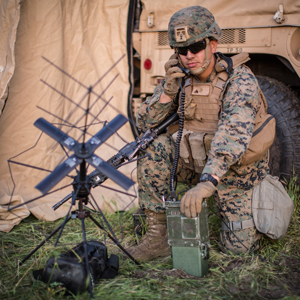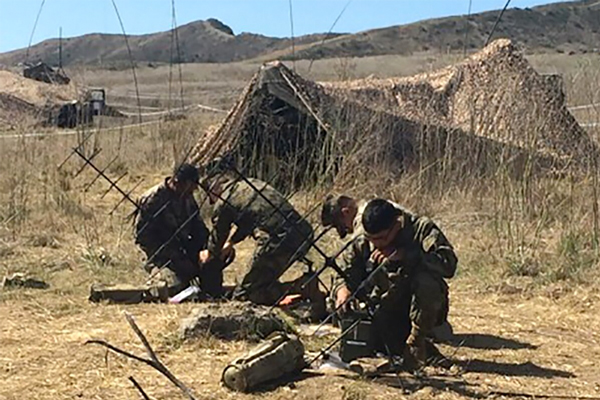
Rainforests and tactical radios don’t get on. Fortunately, help is at hand in ensuring armies can communicate more easily in thick vegetation.
Jungle radio communication
“Jungle radio communication is severely handicapped by radio wave absorption, wherever radio waves must propagate for a considerable distance through the dense, moist jungle vegetation,” noted the United States Army’s Tactical Jungle Communications Study.
This document was published in 1968, three years after the commencement of overt US involvement in the ongoing Vietnam War; a conflict occurring in a country where almost 48 percent of her terrain was covered by jungle.
V/UHF communications
Rainforests create nightmares for conventional Very/Ultra High Frequency (V/UHF: 30MHz to three gigahertz/GHz) tactical communications. V/UHF communications have a Line-of-Sight (LOS) range.
For example, a V/UHF antenna placed three metres (ten feet) above the ground will have a range of approximately seven kilometres (4.4 miles). Yet this line-of-sight range presumes nice, flat open space with no obstacles that could conceivably obstruct the journey of these communications. With its tree canopy and abundant flora such luxuries are not available in jungles.
Environmental Challenges
Another US Army document published while the Vietnam War was ongoing examining field artillery techniques stated that jungle vegetation can reduce V/UHF radio ranges between 10 percent and 60 percent. Such reductions cause problems not only for soldiers, squads and platoons to communicate with one another, but also for ground-to-air/air-to-ground communications.
Dean Booker, Codan’s business development director for tactical communications, served with the British Army’s Royal Corps of Signals and is highly familiar with the challenges jungles cause for tactical communications: “The jungle presents its own unique challenges around the foliage and dense canopy. Communications distances are reduced due to the wet dense foliage that absorbs the signals.”
He added that the environmental conditions cause challenges for the hardware. Electricity and water are not the best of friends, with humidity raising the ambient temperatures within which tactical radios must operate: “Most tropical rainforests have their own climate that is extremely humid and nightly rainfall and thunderstorms add to this.”
Mobile Ad Hoc Networking (MANET)
The latter can become greatly restricted by overhead tree canopy. Contemporary tactical radios use Mobile Ad Hoc Networking (MANET) to establish communications networks: Each transceiver acts as a communications relay, as well as a transmitter and receiver.
Radio traffic too uses the transceivers in a particular network to jump from one radio to the next radio within range, and so on, until the traffic reaches its intended recipient. While this offers a partial solution, the same LOS restrictions apply.
A MANET network used by a battalion in the flat open desert can by definition cover a geographically larger space due to the lack of obstacles between the transceivers. MANET ranges achievable in a jungle where LOS reach will be much shorter will correspondingly diminish.
“In a jungle a MANET radio’s ability to create a network of systems and hop signals though it, allows you to extend your communications range,” observes Brian McDonald, director of field operations for Persistent Systems: “In a high RF (Radio Frequency) absorbing environment, dynamic pathways become massively important. You need a network where the best pathway for data is selected in real time, and where users coming in and out of the network are not going to be an issue.”
Asia-Pacific Jungles Armies
Jungle communications are a concern for armies in the Asia-Pacific. Although local deforestation is a major environmental headache with serious global impacts, the region still boasts 18 percent of the world’s total rainforest; with 26 percent of its land covered by jungle.
Thus there is every chance that future conflicts in the region could be wholly or partially fought by armies in the jungle. This could be especially relevant during counter-insurgency operations where guerrillas may seek to use jungles to hide, organise and mount operations. The challenging topography of a jungle creates other challenges, particularly restricting the areas where vehicles can operate and thus potentially causing more reliance on dismounted patrols.
Booker says that products such as Codan’s Sentry-U 61060-PR personal role radio can provide intra- and inter-squad communications to support jungle operations.
US Army Jungle Tactical Communications
Much as it did during the 1960s the US Army is once again driving research efforts to improve jungle tactical communications. In 2014 the US Department of Defence’s Small Business Innovation Research website published a solicitation for a tactical communications system which can offer between two megahertz and 60MHz of communications bandwidth providing both static and on-the-move communications for deployed troops.
The tricky part is that the radio must be able to transmit through the jungle canopy either to an airborne radio relay mounted on an aircraft, or to a satellite to allow communications traffic to be retransmitted back down to Earth through the trees to the intended recipient.
The challenge was grasped by Gird Systems of Cincinnati, Ohio which initially demonstrated a communications system able to penetrate jungle canopy to provide voice and data communications. The firm won a further award in 2017 for an initiative just short of two years’ duration to transition this work via a grant worth nearly one million dollars. This sees the firm taking its technology to the prototype stage so that it can be demonstrated to the US Army.

Waveforms
At the heart of Gird Systems’ approach is a waveform which works with a prototype software defined radio. Waveforms are essentially the software algorithms radios use to transmit in a particular way to achieve a particular task.
For example, ground-to-air/air-to-ground communications will require a radio to use particular amplifications, bandwidths and transmission security to ensure that a soldier on the ground can efficiently and effectively communicate with an aircraft. Waveforms are pre-loaded into a tactical radio so that the operator does not need to manually tune their set every time they want to communicate in a particular way.
To date, Gird Systems’ technology has demonstrated that it can achieve transmission ranges of up to 56.3km (35 miles) through dense jungle canopy. What is more, this has been achieved with a low signal-to-noise ratio. Put simply, this is the measurement of desired signal that contains the traffic compared to background noise. The low signal-to-noise ratio in this case means that the communications remain clear despite the challenges inherent in the jungle environment.
The MUOS initiative
Staying with waveforms the US Department of Defence’s (DOD) Mobile User Objective System (MUOS) narrowband military satellite communications system can help troops so equipped communicate in jungles.
The MUOS initiative provides a waveform which can perform satellite transmissions across a waveband of 300MHz to three gigahertz. Although MUOS is a narrowband UHF waveform it can be ported into existing DOD tactical radios.

For example, the US Army’s General Dynamics AN/PRC-155 and L3Harris AN/PRC-117G V/UHF manpack radios covering frequencies of 30MHz to three gigahertz have received the MUOS waveform. The goal of the waveform is to provide the soldier with ‘cellphone’ like connectivity in terms of intuitiveness and clarity, and usefully it can penetrate jungle foliage.
As of May 2018, the following radios were being equipped to carry the MUOS waveform beyond those discussed above. These include General Dynamic’s AN/USC-61C High Frequency (HF: three megahertz to 30MHz) and V/UHF maritime radio, plus the US Army’s L3Harris AN/PRC-158 manpack transceivers, Collins Aerospace’ AN/PRC-162 TruNet V/UHF manpack/vehicular radio, the same company’s AN/ARC-210 V/UHF airborne radio used by all five of the US armed forces and the handheld L3Harris AN/PRC-163 V/UHF transceiver also used throughout the US armed services.
The big attractions for the MUOS waveform concerning jungle communications is that it can be ported into those radios listed above avoiding the need to purchase new transceivers. Secondly, the waveform can be used while static or on-the-move with a minimum of accompanying SATCOM infrastructure. Nonetheless, MUOS only offers narrowband communications. What is more, as a US DoD proprietary waveform certainly countries may not have access to it, or the transceivers which can accommodate it.

Low and Medium Frequency wavebands

McDonald says that another approach to solving the riddle of jungle tactical communications can be found by using comparatively lower frequencies compared to V/UHF for transmissions.
Low Frequency and Medium Frequency wavebands of 30 kilohertz/KHz to 300KHz and 300KHz to three megahertz respectively employ surface wave transmissions. The clever thing about surface wave communications is that they follow the curvature of the Earth as opposed to travelling in a straight LOS fashion a la V/UHF communications. These characteristics allow LF and MF to transmit over-the-horizon as the signals bend around the Earth.
LF/MF Challenges
Nonetheless, despite offering promise for jungle communications the use of lower frequencies has drawbacks. Firstly the efficiency of the transmission will depend on the terrain traversed by the transmissions. Moisture on the ground or in the soil provides good conductivity for LF/MF communications as does swamp, with bodies of water providing particularly good conductivity. Conversely drier urban areas and desert provide bad connectivity.
The moist ground in a jungle yields just the sort of environment that LF/MF communications work well in, although one of the drawbacks is that LF and MF radios are far from mobile: A medium frequency antenna can be between 25m (8ft) to 250m (820ft) high; hardly practical for a foot patrol, but possibly more practical for a static Forward Operating Base (FOB). Even in jungle canopy such large transmissions would probably need to be well camouflaged.
The other challenge is that “lower frequency is fine for voice communications, but has a lower data-handling capacity at a time when the warfighter needs access to high bandwidth capabilities, such as video and sensor data,” McDonald cautions.
HF communications
HF communications do not offer much additional utility in the jungle environment where these signals suffer significant RF attenuation. Attenuation is the phenomenon where signals can lose some of their strength as they travel and encounter solid objects, buildings, the atmosphere, people and animals.
The abundance of vegetation can cause significant attenuation problems for HF leading to losses of signal strength. This reduces the range such communications can achieve when performing ground-wave surface-to-surface communications, and the quantities of data that HF radios can handle.
Usefully, HF radios can use the ionosphere. This is an upper layer of the atmosphere between 60km (37.3 miles) and 1,000km (621.5 miles) altitude. This is electrically charged layer cannot be penetrated by HF transmissions. Instead, HF signals hit the ionosphere and bounce back to Earth which allows them to achieve their intercontinental ranges.
HF radios still require antennas that can penetrate jungle canopy to perform these sky wave transmissions. Like its LF and MF counterparts, for this reason HF tactical radios maybe best suited to equipping static installations such as FOBs.
Conclusion
Short of a major technological breakthrough occurring in the near future it appears that armies in the Asia-Pacific and elsewhere will have to continue relying on a surfeit of disparate capabilities to ensure that they can remain connected in the jungle environment.
LF, MF and to a lesser extent HF all enable static bases to remain in contact with one another albeit at the cost of bandwidth. Satellite communications performs a similar role although terminals need to be situated in areas free of obstructions to communicate with the spacecraft overhead. Conventional V/UHF tactical communications using MANET provide the best means for deployed formations to remain in contact, albeit at shorter ranges compared to those achievable in less obstructed environments.
Innovations in terms of waveforms could offer promise in increasing range and data carriage still further, although it must be stressed that such breakthroughs remain at the prototype stage for now. For the time being, it appears that rainforests will continue to tax the signaller’s skills to the maximum.










